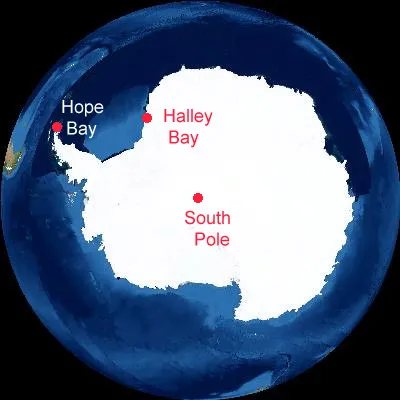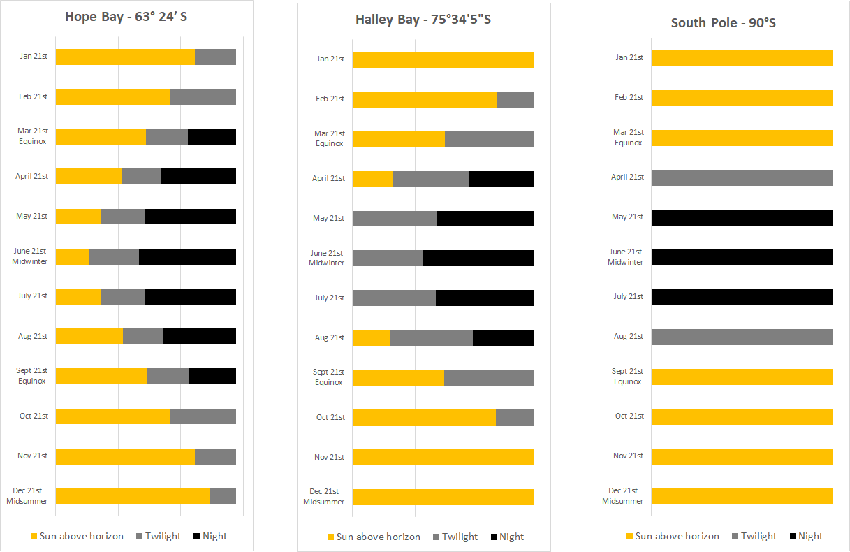Day Length in Antarctica
These animated simulations are taken as from an altitude of 35,785km directly above the South Pole.
Midsummers
Day
21st of December
The day of greatest daylight in the southern hemisphere.
Within the Antarctic Circle there is 24 hours where the sun is above the horizon. At the edge of this area the sun dips below the horizon for a short time each day so for days or weeks there will be a period of twilight each day in the middle of the night rather than full lightness before the sun rises above the horizon again.
The closer to the pole you get, the longer the period of 24 hour daylight when the sun is above the horizon leading to weeks and months of permanent daylight. The extreme situation is at the pole itself where the sun is above the horizon for 6 months of the year
Midwinters
Day
21st of June
The day of least daylight in the southern hemisphere.
Within the Antarctic Circle there is 24 hours where the sun is below the horizon. At the edge of this area the sun rises above the horizon for a short time each day so there will be a period of twilight each day in the middle of the day rather than full darkness before the sun drops below the horizon again.
The closer to the pole you get, the longer the period with full 24 hours of darkness, at the pole itself there is 6 months of darkness, at the start and end of which the sun comes close to the horizon but not above it giving a period of twilight each day.
The
Equinoxes
21st of March and 21st of September
12 hours of daylight followed by 12 hours of darkness over almost the whole of the planet.
Depending on whether it is spring or autumn and whether you are in the northern or southern hemisphere, daylength is now at the tipping point of more of one than the other.
The equinoxes are the times when daylength is changing most quickly bringing in spring and summer or autumn and winter.
Winter Darkness, Summer Light

The closer you get to the poles, the more extreme the differences in daylight are throughout the year.
At the equator there are about 12 hours and 7 minutes a day where the sun is above the horizon throughout the year with a variation of 2 minutes. The equator has the shortest period of twilight before sunrise and after sunset of anywhere on the planet, when the sun rises and sets it does so quickly and the transition from or to full dark night is swift.
Three locations in Antarctica are given, Hope Bay at 63° 24' S, at the most northerly tip of continental Antarctica on the Peninsula and outside the Antarctic Circle (66° 33° 45.9° S) , Halley Bay at 75° 34' S, well inside the Antarctic Circle and the South Pole at 90° S.

Twilight - The closer to the poles you get, the longer the twilight period each day which can stretch to several hours. Twilight is defined as being the period where the sun is less than 18 degrees below the horizon, in the summer months in Antarctica, even at midnight, the sun may be less than this amount below the horizon, so the full darkness of night is never reached before the sun starts to come up again.
Snapshots - Each horizontal bar on the charts represents a single day on the 21st of each month and so is a snapshot of that day and not necessarily an average for that month. This is done for the sake of making the data easier to interpret and less cluttered.
South Pole - The transition from day to twilight is very quick at the South Pole at the equinoxes. So while on the 21st of March, the sun is still above the horizon, so there is a whole daylight bar, two days later on the 23rd of March the sun is below the horizon, so there would be a whole twilight bar. Similarly in September the 21st is full daylight while two days earlier on the 19th it would be full twilight. The result is that there is almost a whole "hidden" month of twilight for the South Pole data and it looks like there is a whole extra month of daylight more than there really is - there isn't.
Acknowledgements:
Globes from various perspectives
derived from the excellent
Earth Viewer, used courtesy of John Walker of Fourmilab, Switzerland
and NASA
